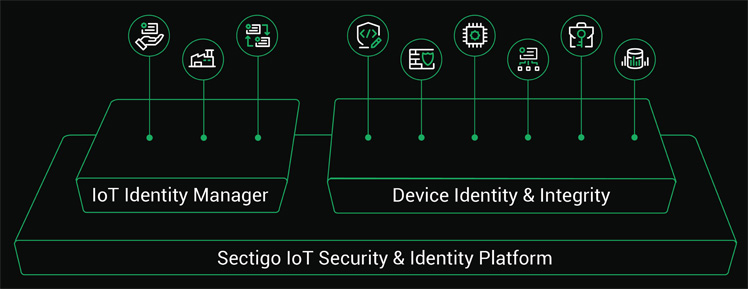Sectigo improves IoT security platform
- December 28, 2020
- Steve Rogerson

Sectigo, a New Jersey-based provider of automated digital identity management and web security, has improved its IoT security and identity management platform, making integration and management of secured connected devices easier for OEMs and enterprises.
The innovations include a PKI client software development kit (SDK) for Sectigo IoT Manager and secure boot SDK, which eases development efforts and reduces time to market for manufacturers across industries.
The all-in-one IoT security platform simplifies securing and authenticating connected devices, so enterprises can protect their infrastructure in a way that is scalable, cost-effective and easy to manage.
“No other platform makes it as easy to ensure that connected devices are authenticated and to maintain reliable security from initial production on the assembly line, through installation and operation, until final decommissioning,” said Alan Grau, vice president at Sectigo. “The integrity of connected endpoints in healthcare, transportation, energy, financial services and smart city sectors – our critical infrastructure – depend on it.”
The IoT security platform delivers end-to-end security services for every class of connected device, from manufacture through its lifecycle, enabling OEMs to build secure devices that are compliant with security standards and new IoT security regulations. Best-practice features, myriad technology integrations and single pane of glass management can empower enterprises to protect their IoT infrastructure in a way that is scalable, cost-effective and easy-to-manage.
In addition, the platform leverages the infrastructure used for issuing public certificates, providing IoT OEMs with the same high levels of security as public roots provide.
Multi-vendor ecosystem support means IoT Manager now provides more configurability and customisation of certificate profiles, enabling support for the requirements of emerging IoT ecosystems.
The PKI client for IoT Manager SDK makes it easier for Sectigo customers to issue certificates programmatically from the IoT Manager platform using the Rest API interface.
The EST PKI client uses the enrolment over secure transport (EST) cryptographic protocol for PKI, enabling automated use of EST for those using Sectigo Certificate Manager.
The latest release of Sectigo’s embedded firewall SDK includes support for Green Hills Software’s Integrity RTOS microkernel architecture, designed for critical embedded systems that demand proven separation, security and real-time determinism. The SDK helps device manufacturers add firewall protection to enforce configurable packet filtering rules on connected devices.
Sectigo has integrated the company’s secure boot SDK with the NetObjex PiQube IoT development platform, providing manufacturers using the platform with secure boot functionality, thereby ensuring authenticity of the firmware on their devices.
“Sectigo’s secure boot SDK delivers code signing and validation tools, ensuring the firmware on our devices is protected from hackers,” said Raghu Bala, CEO of NetObjex. “The easy to use SDK enabled us to quickly and easily add secure boot to our device. The growth of edge devices has increased the risk of devastating data breaches. Offering Sectigo’s embedded device hardening technologies and purpose-built third-party certificate issuance and management provides our customers with assurance that their important data and devices are protected.”
Sectigo has been selected to provide PKI services for the Wireless Broadband Alliance OpenRoaming ecosystem.
Sectigo is a cyber-security provider of digital identity technology, including TLS and SSL certificates, devops, IoT and enterprise-grade PKI management, as well as multi-layered web security. As a certificate authority with more than 700,000 customers and over 20 years of experience in online trust, Sectigo partners with organisations of all sizes to deliver automated public and private PKI for securing web servers, user access, connected devices and applications.




